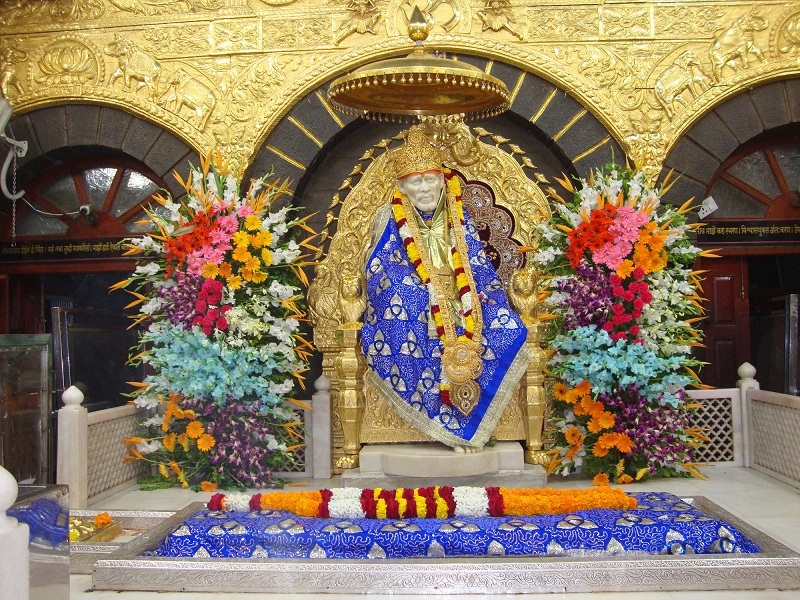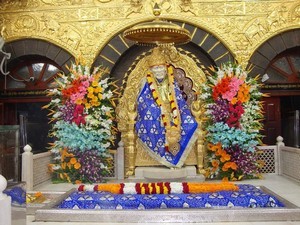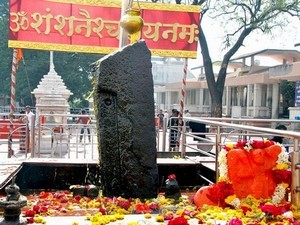Shirdi Sai Baba Temple, Shirdi - Timings, Festivals, History, Darshan, Pooja Timings
Photo Credit: Flickr
 India | Maharashtra | Shirdi
India | Maharashtra | Shirdi
 #1 of 7 Places to Visit in Shirdi
#1 of 7 Places to Visit in Shirdi
 Distance (From Shirdi Bus Station): 0.6 Kms
Distance (From Shirdi Bus Station): 0.6 Kms
 Trip Duration (Including Travel): 4 Hours/Half Day
Trip Duration (Including Travel): 4 Hours/Half Day
 Transportation Options: Walk/Trek
Transportation Options: Walk/Trek
 Travel Tips: Different darshan methods are available in Shirdi. There is always a huge queue for darshan which can be done through the paid darshan or through the free darshan. Special Sevas and paid darshans are a little faster than the free queue. Usually it takes 2-3 hours and it takes 4-6 hours during festivals & special occations. Around 50,000 people come to visit the temple everyday and the number goes up to about one lakh on weekends and festivals.
Travel Tips: Different darshan methods are available in Shirdi. There is always a huge queue for darshan which can be done through the paid darshan or through the free darshan. Special Sevas and paid darshans are a little faster than the free queue. Usually it takes 2-3 hours and it takes 4-6 hours during festivals & special occations. Around 50,000 people come to visit the temple everyday and the number goes up to about one lakh on weekends and festivals.
About Shirdi Saibaba Temple
At a distance of 600 m from Shirdi Bus Stand, Sri Shirdi Sai Baba Temple is a prominent Hindu temple situated in the center of Shirdi town in Maharashtra. It is one of the most famous pilgrimage sites in India and among the prime place to include in your Shirdi tour packages. The Shirdi Temple is dedicated to Sri Sai Baba, who is revered as one of the greatest saints ever seen in India, endowed with unprecedented powers. Baba first made his appearance in Shirdi as a youth and remained there until he died in 1918. He transformed the lives of those who met him and continuously is doing so even after his Samadhi for those who pray him for his blessings.
History of Shirdi Saibaba Temple
Sai Baba is recognized to have been born into a Hindu Brahmin family before being taken in by a Sufi fakir. He is said to have arrived in the village of Shirdi at approximately 16 years of age, appearing as a fakir. While biographers do not agree on the exact date of this occurrence, it is widely believed that Baba resided in Shirdi for three years, vanished for a year, and then returned permanently around 1858, indicating a potential birth year of 1838. He led a life of asceticism, often found sitting in meditation under a neem tree in a traditional asana. The true name of Sai Baba remains unknown; the name 'Sai' was bestowed upon him by the temple priest Mahalsapati upon his return to Shirdi in 1858. By 1910, Sai Baba's reputation began to grow, attracting numerous visitors. He passed away on 15 October 1918, coinciding with the Vijayadashami festival. A temple was constructed around his tomb (samadhi) in 1922, and the temple complex underwent renovations in 1998, now featuring modern amenities and essential facilities.
Architecture of Shirdi Saibaba Temple
The temple complex of Sri Shirdi Sai Baba is spread in approximately 200 square meters. Samadhi Mandir is the main temple in the complex and is the mausoleum where Baba's mortal remains lay preserved. Samadhi Mandir was constructed under the patronage of a millionaire from Nagpur, who was an ardent devotee of Sai Baba. The Sai devotee, Shreemant Gopalrao, wanted to enshrine an idol of Murlidhar at the temple, but Sai Baba declared himself as Murlidhar. A life-size marble idol of Baba is placed here which is worshipped by the devotees visiting the temple. The idol was made by Late Balaji Vasant in 1954. A large hall in the Samadhi Mandir accommodates hundreds of devotees for prayers and darshan each day.
Apart from the Samadhi Mandir, Shirdi Sai Baba Temple premises houses a Gurusthan which is the spot where a neem tree is worshipped. According to the legend, Sri Sai Baba's remains were entombed under this neem tree. The mosque where Sai Baba spent most of his life, Dwarkamai is another sacred spot that is enshrined in the premises. Situated close to Dwarkamai Mosque, Chavadi is the place where Sai Baba came along with his followers on every alternative night to sleep. The temple premises enclose a large Lendi Baug, where Sai Baba used to go every day in the morning and afternoon for watering the plants. There are also small shrines for Shiva, Ganesh, and Shani on the premises. The temple also houses a museum that showcases Baba's personal articles of use.
The temple is open to all visitors irrespective of their caste, religion, and beliefs. On average, daily 50,000 devotees visit Shirdi, to have the Darshan of Sri Sai Baba. In the festival season, more than 100,000 devotees visit the temple every day.
Festivals of Shirdi Saibaba Temple
The Shirdi Sai Baba temple observes three principal festivals: Shri Ram Navami in March/April, Guru Purnima in July, and Vijayadashami, also known as Dussehra, in September/October. These celebrations are marked by profound devotion and hold great importance for the followers of Sai Baba.
Shirdi Saibaba Temple Dress Code & Other Restrictions
When planning a visit to the Shirdi Saibaba Temple, it is recommended to adhere to modest clothing that covers your upper arms and legs as a sign of respect. Men are encouraged to wear a dhoti or pajama paired with an upper garment, as well as formal trousers and shirts. Women may opt for a saree, half saree, or chudidhars. It is advisable to refrain from wearing contemporary attire such as mini-skirts, shorts, and sleeveless tops while on the temple grounds.
There are no restrictions on who can visit the temple, and the temple premises are open to all, regardless of their religious affiliation.
Shirdi Saibaba Temple Timings
Monday: 5:30 AM - 10:30 PM
Tuesday: 5:30 AM - 10:30 PM
Wednesday: 5:30 AM - 10:30 PM
Thursday: 5:30 AM - 10:30 PM
Friday: 5:30 AM - 10:30 PM
Saturday: 5:30 AM - 10:30 PM
Sunday: 5:30 AM - 10:30 PM
Shirdi Saibaba Temple Entry Fee
General Entry is Free
Special Darshan available for Rs. 200
Kakad Aarti (5 AM) for Rs. 600
Afternoon and Night Aartis for Rs. 400
Best Time to Visit Shirdi Saibaba Temple
The optimal time to visit Shirdi is year-round; however, the peak season occurs from October to November, when the climate is enjoyable and suitable for sightseeing. The temple sees the highest footfall during festivals such as Dussehra and Rama Navami, so it is advisable to plan your visit accordingly and secure accommodations in advance if you intend to travel during these times. It is preferable to refrain from visiting the temple in the summer months, as Shirdi experiences hot and humid conditions during this period. Additionally, from June to September, Shirdi experiences moderate to heavy rainfall, which may hinder your exploration of the town.
How to Reach Shirdi Saibaba Temple
Pune International Airport is the nearest airport, which is about 185 Km from Shirdi and has daily flights from Mumbai, Bangalore, Hyderabad, Chennai, Kochi, Delhi, Kolkata, and Goa. Shirdi is well connected by train with Ahmednagar, Pandharpur, Chennai, Hyderabad, Aurangabad, Kalka, Mumbai, Pune, Nashik, Chandigarh, Delhi, Agra, Bhopal, Manmad, Puri, Vijayawada, Vizag, Tirupati, and Mysore. Manmad Junction Railway Station is the major railhead, which is about 58 Km from Shirdi. Shirdi lies on the Ahmednagar-Manmad Highway and is well-connected by bus to major cities like Nashik, Aurangabad, Mumbai, Pune, Goa, Ahmednagar, Ahmedabad and Hyderabad. One can reach the temple by foot or by hiring an auto-rickshaw from the bus stand.













